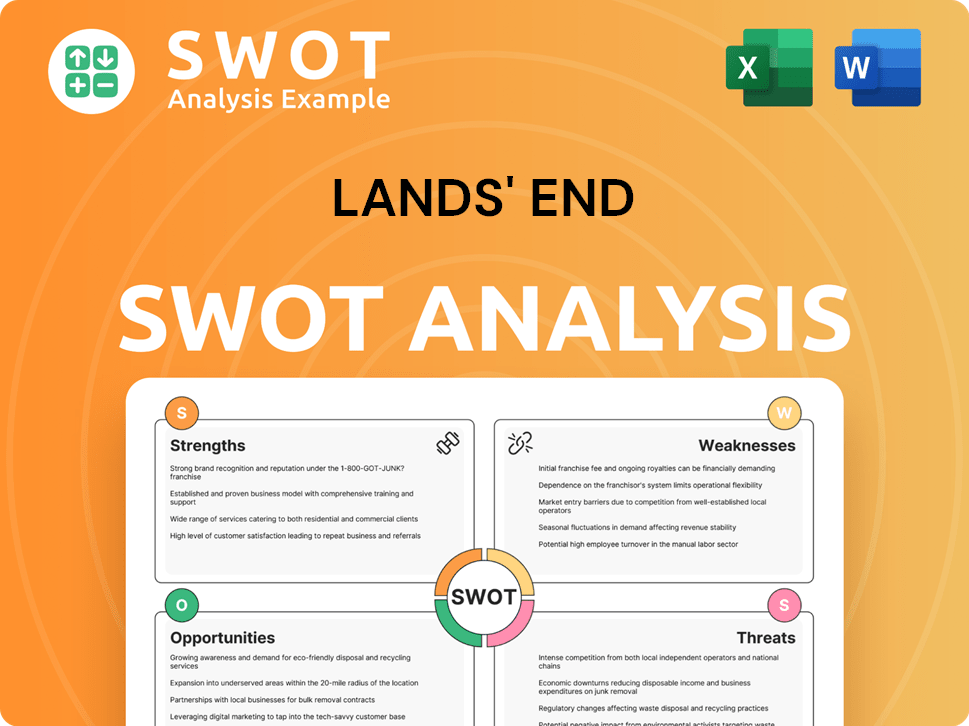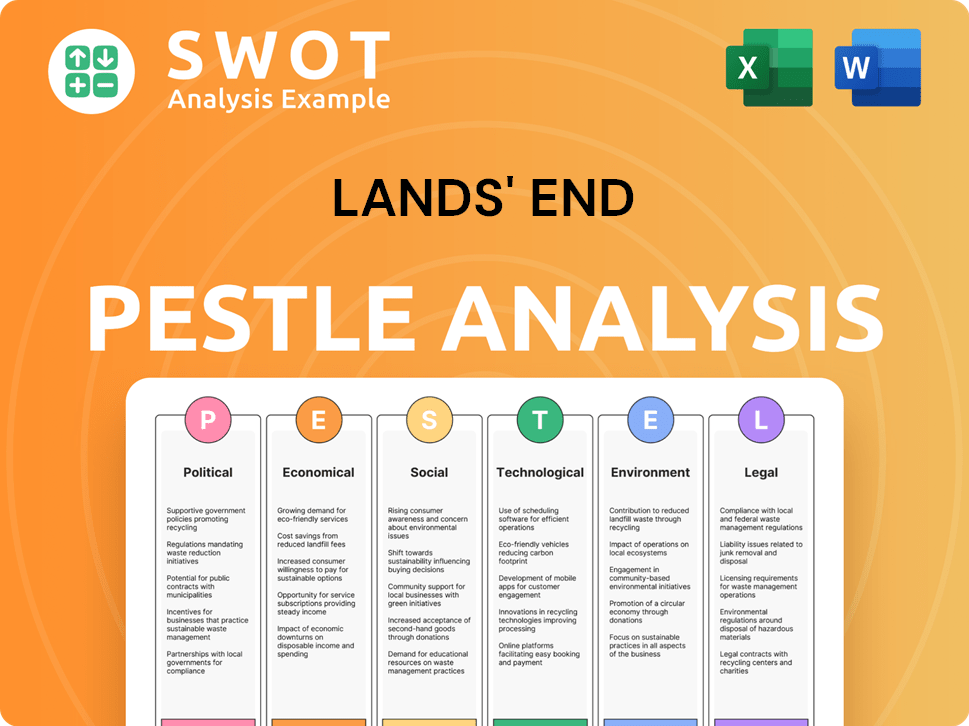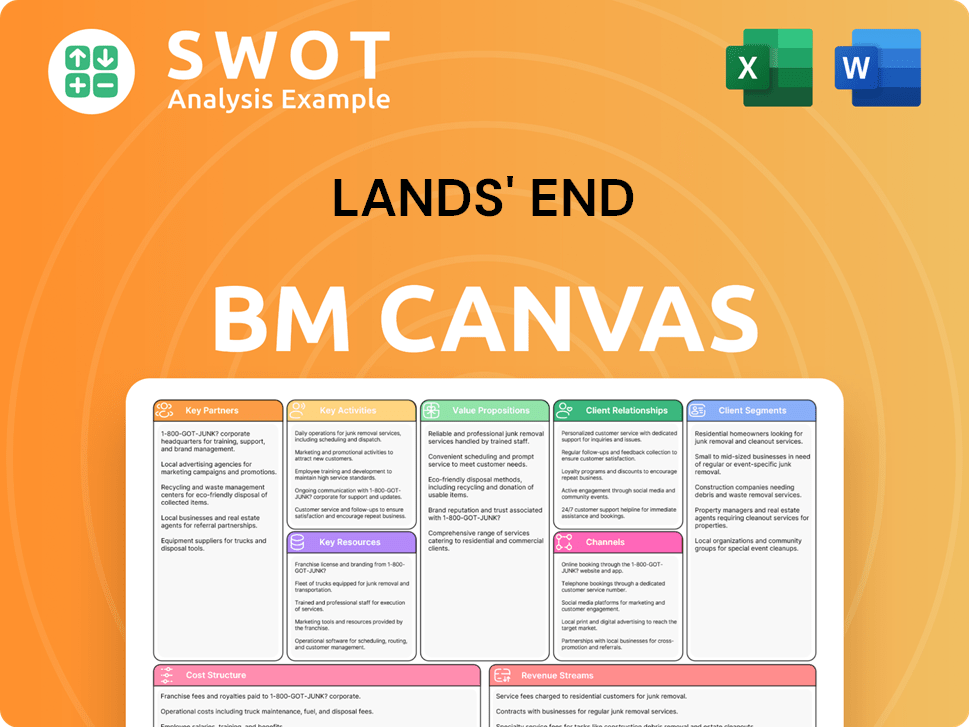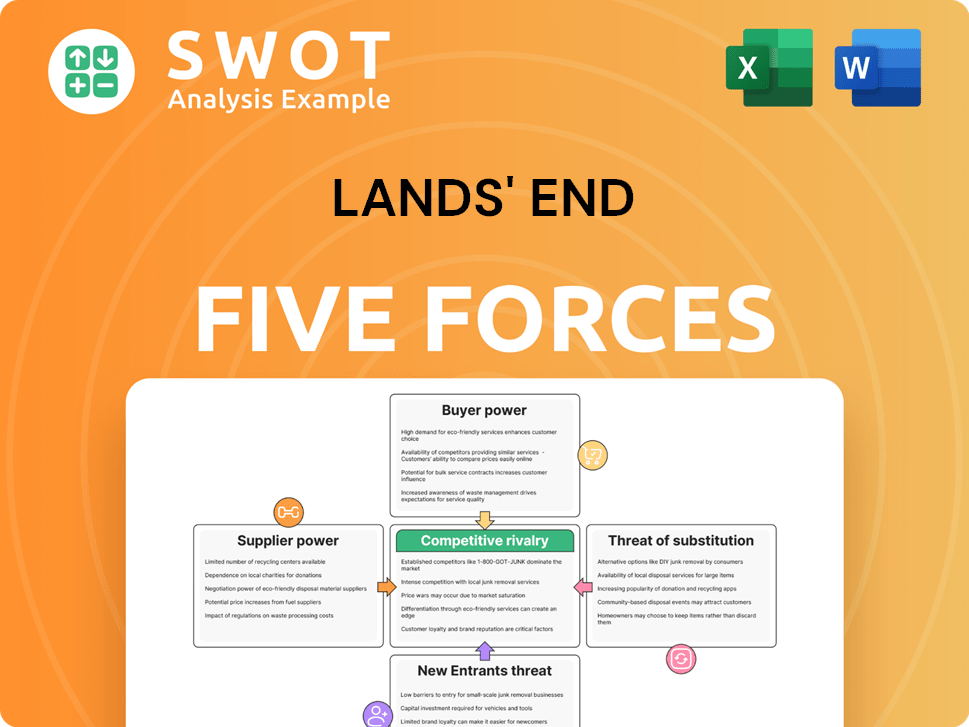Lands' End Bundle
How Did a Yachting Catalog Become a Retail Giant?
Journey back to 1963 and uncover the Lands' End SWOT Analysis, a story of innovation and adaptation. From its accidental birth to its current status as a leading retailer, Lands' End's history is a fascinating tale of resilience. Discover how this iconic brand navigated the ever-changing retail landscape, evolving from a mail-order business to a multi-channel powerhouse.

This brief history of Lands' End explores the Lands' End company's remarkable journey. From its Lands' End founder Gary Comer's vision to its current omnichannel strategy, the Lands' End brand has consistently prioritized customer satisfaction. Delving into the Lands' End timeline reveals key milestones, including the evolution of its product line and its strategic adaptation to digital commerce, solidifying its place in the apparel industry.
What is the Lands' End Founding Story?
The story of the Lands' End company begins in 1963, marking the start of a journey that would transform the retail landscape. Founded by Gary Comer, a sailing enthusiast, the company initially focused on providing quality equipment to a specific niche market.
Comer, along with his partners Richard Stearns and Robert Halperin, and two of Stearns' employees, launched Lands' End as a mail-order business. This venture was a direct response to the demand for specialized yachting supplies, offering a convenient catalog model to reach customers.
The company's early days were characterized by resourcefulness and a commitment to customer service, principles that would define its future. The company's origin story reflects a blend of entrepreneurial spirit and a keen understanding of a specific market's needs.
Lands' End was founded in 1963 by Gary Comer, along with partners, starting as a mail-order business for sailboat equipment.
- The company's name, 'Lands' End,' was the result of a typographical error on the first catalog.
- The initial focus was on providing high-quality yachting supplies through a catalog, catering to a niche market.
- Gary Comer's motto, 'Take care of the customer, take care of the employee and the rest will take care of itself,' guided the company.
- The company's early success was influenced by the growing interest in leisure activities like sailing in the 1960s.
The company's first catalog, the 'Lands' End Yachtsman's Equipment Guide,' showcased its initial product offerings. The early business model was bootstrapped, reflecting the entrepreneurial spirit of the time. The company's focus on customer service and quality products helped it establish a loyal customer base. The Target Market of Lands' End evolved over time, starting with racing sailors and expanding to a broader audience.
The early years of Lands' End were marked by a commitment to quality and customer satisfaction. This approach helped the company build a strong reputation and establish itself in the market. The company's ability to adapt and evolve has been key to its longevity and success.
Lands' End SWOT Analysis
- Complete SWOT Breakdown
- Fully Customizable
- Editable in Excel & Word
- Professional Formatting
- Investor-Ready Format

What Drove the Early Growth of Lands' End?
The early growth of the Lands' End company was significantly shaped by its mail-order business, initially focused on yachting supplies. This success necessitated a move to larger facilities on Chicago's Elston Avenue. The company's strategic shift towards general clothing and home furnishings marked a pivotal moment, leading to its relocation to Dodgeville, Wisconsin, in 1978, where its headquarters remain today.
In October 1986, the Lands' End history was further defined by becoming a public company through an initial public offering (IPO). The late 1980s also saw the company expanding its apparel offerings, including serving as the jersey supplier for the United States national rugby union team. These moves highlighted the company's expanding market reach and product diversification.
Demonstrating its foresight, the Lands' End brand launched its website, Landsend.com, in July 1995, establishing an early online presence. This early adoption of e-commerce allowed the company to capitalize on the growing online retail trend. By fiscal 2023, online retail orders in the U.S. accounted for 63.2% of its revenue, showcasing the continued importance of its e-commerce business.
The company diversified its sales channels, including third-party distribution and company-operated stores, with 26 stores in operation as of February 2, 2024. The Outfitters distribution channel, offering customized apparel, further broadened its market reach. In fiscal 2024, the Licensing and Retail business grew by nearly 60%, driven by the licensing model.
The company focused on optimizing promotional activity and leveraging product newness to enhance profitability. Gross margins reached their highest level since 2017 in fiscal 2024, expanding by 550 basis points to nearly 48%. This strategic shift, including the transition of kids and footwear product lines to licensing arrangements, has aimed to drive higher quality sales.
Lands' End PESTLE Analysis
- Covers All 6 PESTLE Categories
- No Research Needed – Save Hours of Work
- Built by Experts, Trusted by Consultants
- Instant Download, Ready to Use
- 100% Editable, Fully Customizable

What are the key Milestones in Lands' End history?
The Lands' End history is marked by significant milestones that have shaped its evolution from a direct-mail catalog business to a prominent player in the apparel industry. The
Lands' End company
has consistently adapted to market changes, expanding its reach and product offerings over the years.| Year | Milestone |
|---|---|
| 1963 | Lands' End founder, Gary Comer, establishes the company, initially focusing on sailing equipment and apparel. |
| 1970s | The company transitions to a broader apparel catalog, expanding its product line and customer base. |
| 1995 | Lands' End launches its website, marking a significant step into e-commerce. |
| 2002 | Lands' End is acquired by Sears. |
| 2014 | Lands' End is spun off from Sears as an independent, publicly traded company. |
| March 2021 | Lands' End officially launches its Marketplace, expanding its digital offerings. |
Lands' End has been at the forefront of several innovations that have defined its business model. Early adoption of e-commerce was a key move, with the launch of its website in 1995. The company's commitment to customization, offering options like monogramming, also sets it apart.
Lands' End was an early adopter of e-commerce, launching its website in 1995, which allowed it to reach a wider audience. This early investment in online retail helped the company establish a strong digital presence.
In March 2021, Lands' End launched its Marketplace, which expanded its product offerings by allowing third-party sellers. This strategic move broadened the company's product range and enhanced its digital platform.
Lands' End distinguishes itself through customization options, such as monogramming and custom-fit swimwear. These features enhance customer engagement and foster brand loyalty.
The company has embraced digital transformation, using technologies like generative AI for customer service and data analytics. This focus on technology supports go-to-market strategies and operational efficiency.
Lands' End has focused on improving inventory management, achieving an eighth consecutive quarter of inventory reduction in fiscal 2024. This focus helps to optimize costs and improve profitability.
Lands' End is committed to sustainability, aiming to source 100% of its cotton from sustainable sources by 2025. The company has also committed to achieving net-zero emissions by 2050.
Despite its successes, Lands' End has faced significant challenges. Market downturns and intense competition in the apparel industry have impacted its financial performance. The company has experienced periods of declining revenue, as seen in fiscal year 2024.
Lands' End faces intense competition from both established and emerging apparel brands. This competitive landscape requires continuous innovation and adaptation to maintain market share.
Lands' End has experienced fluctuations in revenue, with net revenue decreasing by 7.4% to $1.36 billion in fiscal 2024. These fluctuations highlight the impact of market conditions and strategic decisions.
The transition of kids and footwear product lines to licensing arrangements has also affected revenue. These changes require careful management to ensure sustained profitability.
Economic downturns and changes in consumer spending habits can negatively impact sales. Adapting to these external factors is crucial for maintaining financial stability.
Evolving consumer preferences and fashion trends require Lands' End to constantly update its product lines. Staying relevant in a dynamic market is a key challenge.
Global supply chain disruptions can create challenges in sourcing materials and delivering products. Managing these disruptions is essential for operational efficiency.
Lands' End Business Model Canvas
- Complete 9-Block Business Model Canvas
- Effortlessly Communicate Your Business Strategy
- Investor-Ready BMC Format
- 100% Editable and Customizable
- Clear and Structured Layout

What is the Timeline of Key Events for Lands' End?
The Lands' End company has a rich history, evolving from its origins as a mail-order yachting supply company to a well-known brand. Here is a chronological timeline of key events for Lands' End, showcasing its growth and adaptation over the years.
| Year | Key Event |
|---|---|
| 1963 | Lands' End, a mail-order yachting supply company, was founded by Gary Comer in Chicago, Illinois. |
| 1977 | The company began to shift its focus from sailing supplies to general clothing and home furnishings. |
| 1978 | Lands' End began its migration to Dodgeville, Wisconsin, which became its headquarters. |
| 1986 | Lands' End became a public company through an initial public offering (IPO). |
| 1995 | Lands' End launched its website, Landsend.com, expanding its online presence. |
| 2014 | Lands' End spun off from its then-owner, Sears. |
| 2021 | Lands' End officially launched its third-party marketplace. |
| March 2024 | Lands' End's board authorized a new share repurchase program for up to $25 million through March 2026. |
| Q4 Fiscal 2024 (ended January 31, 2025) | Lands' End reported net income of $18.5 million and a gross margin of 45.6%. Full-year fiscal 2024 net revenue was $1.36 billion. |
| March 2025 | Lands' End announced it is exploring strategic alternatives, including a potential sale or merger, to maximize shareholder value. |
Lands' End is focused on boosting cash flows and prioritizing its licensing strategy. For fiscal year 2025, the company projects net revenue between $1.33 billion and $1.45 billion. The company anticipates adjusted EBITDA to be in the range of $95 million to $107 million, and adjusted net income is projected between $15 million and $27 million. Capital expenditures for fiscal 2025 are expected to be approximately $30 million.
The company is investing in enhancing its e-commerce capabilities and diversifying its product offerings. Lands' End is also pursuing strategic partnerships and collaborations. This approach is designed to meet evolving consumer expectations and expand market reach, solidifying its position in the competitive apparel market.
Lands' End is committed to sustainability, aiming to procure 100% of its cotton from more sustainable sources by 2025. The company is working towards net-zero emissions by 2050. These initiatives reflect a modern, digitally focused, forward-looking brand, while still adhering to the founding vision of quality and customer service.
The company is exploring strategic alternatives, including a potential sale or merger, to maximize shareholder value. The focus on high-quality sales aims to drive additional gross profit dollars and gross margin expansion over the long term. These efforts are designed to ensure continued growth and relevance in the apparel industry.
Lands' End Porter's Five Forces Analysis
- Covers All 5 Competitive Forces in Detail
- Structured for Consultants, Students, and Founders
- 100% Editable in Microsoft Word & Excel
- Instant Digital Download – Use Immediately
- Compatible with Mac & PC – Fully Unlocked

Related Blogs
- What is Competitive Landscape of Lands' End Company?
- What is Growth Strategy and Future Prospects of Lands' End Company?
- How Does Lands' End Company Work?
- What is Sales and Marketing Strategy of Lands' End Company?
- What is Brief History of Lands' End Company?
- Who Owns Lands' End Company?
- What is Customer Demographics and Target Market of Lands' End Company?
Disclaimer
All information, articles, and product details provided on this website are for general informational and educational purposes only. We do not claim any ownership over, nor do we intend to infringe upon, any trademarks, copyrights, logos, brand names, or other intellectual property mentioned or depicted on this site. Such intellectual property remains the property of its respective owners, and any references here are made solely for identification or informational purposes, without implying any affiliation, endorsement, or partnership.
We make no representations or warranties, express or implied, regarding the accuracy, completeness, or suitability of any content or products presented. Nothing on this website should be construed as legal, tax, investment, financial, medical, or other professional advice. In addition, no part of this site—including articles or product references—constitutes a solicitation, recommendation, endorsement, advertisement, or offer to buy or sell any securities, franchises, or other financial instruments, particularly in jurisdictions where such activity would be unlawful.
All content is of a general nature and may not address the specific circumstances of any individual or entity. It is not a substitute for professional advice or services. Any actions you take based on the information provided here are strictly at your own risk. You accept full responsibility for any decisions or outcomes arising from your use of this website and agree to release us from any liability in connection with your use of, or reliance upon, the content or products found herein.